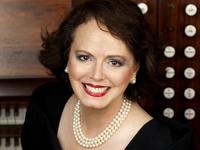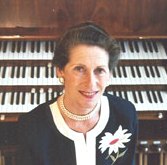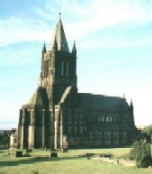|
|
-
|
FUGUE:
CHAPTER X
THE
CENTENARY CELEBRATIONS MAY TO SEPTEMBER, 1979
|
|
Extract
from the talk given on Sunday, 27th
May,1979, an adaptation from the talk given by Ralph Downes
on BBC Radio 3 prior to the broadcast of a recital from St.
Bartholomew's by Nicolas Kynaston. 15 April, 1975.
If
it could be said that 17th and 18th century organ-building in
England was shaken out of conservatism, revitalised and
eventually dominated by the influx of European traditions
through the agency of "Father" Smith, Réné
Harris, John Snetzler and others, until a new conservatism was
reached and bogged it down again; then one could argue that an
equally radical process set in during the second half of the
19th century, stemming from the person and work of the German
Edmund Schulze, who was born in 1824.
Especially
remarkable in Schulze's organs, and clearly demonstrated at
Armley, is the employment of wooden pipes to produce the
"string" sonorities so favoured in German 19th
century organ building. Other features are the stupendous
magnificence of the main "Principal chorus" - totally
unlike the Baroque style except in its use of very moderate
wind pressure - and the uniform application of the system of
diameter-scaling of the pipes, devised by the eminent
physicist, Professor J. G. Töpfer in early mid-19th
century. Equally noteworthy is the profusion of delicately
voiced stops of various sonorities in the Choir and Echo
divisions - although the former is at present suffering partial
eclipse from its buried position behind and under the Great
organ”.
FROM THE 1979 SOUVENIR BOOKLET:
1.
INTRODUCTION by Arnold Mahon, Organist
|
 Nicolas
Kynaston,
Nicolas
Kynaston,
born 1941
|
|
 Arnold
Mahon, born 1942
Arnold
Mahon, born 1942
|
“It
is very difficult to write an introduction to a booklet
celebrating the Centenary of an instrument. If it was the
anniversary of the birth or death of a composer or musician
then we could more easily assess his or her contribution to the
art of music. Perhaps then, it is an appropriate time to thank
the various people who have supported me, and through me the
organ itself, since my appointment to Armley, and who I hope
will continue to do so.
Thanks
are therefore given to the Vicar of Armley, the Rev. Owen A.
Conway, who has actively encouraged the presentation of
concerts featuring the organ and is very keen to see it
properly cared for and restored to a condition fit for its
survival into the twenty-first century;
|
|
to
Kenneth Johnstone, who has worked tirelessly, not only to uncover
all the secrets of this famous instrument and present them in his
excellent and widely acclaimed book, but, in many other ways too,
including talking about the instrument to visitors;
to
Ralph Downes, who having first heard and played the organ in 1947,
has given us so much advice since his return visits in 1974 and
1975 and appointment as Consultant; his experience, expertise and
vision must be second to none; and also to the small band of
enthusiasts from the Parish of Armley who really care and
appreciate that here we have more than a church organ.
Inevitably
and understandably, as in all parishes, the majority of our
worshippers are content with whatever accompaniment is provided
for the singing of choir and congregation, with a little music at
the beginning and end of the service, but it encourages me to know
that a few do realise that somehow the Parish of St. Bartholomew,
Armley, has been "chosen" to be the home of an organ
which is very special, and that it is the duty and privilege of
the parish to maintain it to the best of its ability. Finally, my
thanks to all who by their presence at recitals and concerts show
that this wonderful instrument is appreciated, enjoyed and still
needed one hundred years after its installation in this equally
magnificent building. As I write this I cannot be sure that it
will survive this Centenary Year without the intrusion of some
serious malfunction, but I think it will. The sum now needed to
restore this masterpiece as near as possible to that originally
envisaged by Edmund Schulze, without, I hasten to add, just
turning it into a museum piece, but having due regard to its
primary functions as already mentioned, is a large five figure
sum, and increasing rapidly each year. O that we had a William
Eyres in Armley today!”
2.
FOREWORD from the Rev. Owen Conway, Vicar of Armley from 1973 to
1981
|
The
Rev. Owen Conway,
died 2004
|
|
“Church
Organs are expensive luxuries these days. Most churches faced
with the prospect of raising thousands of pounds to provide a
new instrument or to repair an older one take what many believe
to be the obvious and easy way out, and buy the latest
production model of modern electronics. They see the use of an
organ in a very practical way - accompanying a choir and
encouraging a congregation to open their mouths and sing. There
is no thought of organ recitals or of any special musical
qualities in their choice.
The
point about the Armley Organ is that it not only provides a
thrilling series of sound for the playing of organ music in the
artistic context, but in the very ordinary and routine jobs
involved in the Church's liturgy, it has so much extra to
contribute. In the wide variety of tone colours, it is a
marvellous mood-setter and accompaniment for a choir - a
veritable organ in the hands of the organist. And also in the
leading of singing, and the build up to a climax in worship, it
is second to none. It literally bullies people to sing. But
perhaps we have become so used to it that it is only when we
worship elsewhere that we miss its glorious sounds.
Thank
God for the art of Edmund Schulze. Thank God for William Eyres
whose generosity brought this organ to Armley.”
|
MUSICAL
PROGRAMMES
|
1.
SUNDAY 13 MAY 6.30 pm. Arnold
Mahon (St. Bartholomew)
presented
a popular opening programme
2. MONDAY 21 MAY
8.00 pm. LYNNE DAVIS (PARIS)
Fantasie
et Fugue Alexandre-Pierre-Francois
Boëly
Prelude
& Allegro Vivace from the 1st
Symphony Louis
Vierne
Meditation
from the First Symphony Charles-Marie
Widor
Esquisse
Byzantine Henri
Mulet
Choral
No.1 in E César
Franck
Prière,
Op.20 César
Franck
Choral
Varié sur le Veni Creator Maurice
Duruflé
3.
SUNDAY 27 MAY 3.00 pm. JENNIFER BATE (LONDON) with RALPH
DOWNES
Prelude
& Fugue in D minor Felix Mendelssohn
Preludio
al Vespro di Monteverdi Michael Tippett
Prelude
& Fugue in Eb (BWV 552) J. S. Bach
Short
talk by Ralph Downes
“THE IMPORTANCE OF SCHULZE AT
ARMLEY”
These
four items were recorded by the BBC for Radio 3
Fantasia
& Fugue on “Ad Nos, ad Salutarem Undam” Ferencz
Liszt
4.
MONDAY 4 JUNE 8.00 pm. JAMES BROWN (LEEDS UNIVERSITY)
5.
SATURDAY 9 JUNE 3.00 pm. MEMBERS
OF THE LEEDS ORGANISTS’ ASSOCIATION
including
W. ILES PULFORD (ST. BARTHOLOMEW 1940-1953)
Improvisation
on a Submitted Theme
6.
MONDAY 11 JUNE 8.00 pm. ANTHONY COOKE (LEEDS GRAMMAR SCHOOL)
7.
FRIDAY 15 JUNE 7.30 pm. THE BAND OF YORKSHIRE IMPERIAL
METALS
(The
National Champions)
Musical Director - Denis Carr
8.
SATURDAY 16 JUNE 7.30pm. FRANCIS JACKSON (YORK MINSTER)
Prelude
& Fugue in C minor Felix
Mendelssohn
Partita,
Op.19 William
Mathias
Fantasie
in A César
Franck
Esquisses,
Op.41 Marcel
Dupré
Legende,
Op.31 No.13 Louis
Vierne
Sonata
3 (1st
performance) Francis
Jackson
Prelude
& Fugue on the name of Bach Ferencz
Liszt
9.
TUESDAY 19 JUNE 7.30 pm. THE CHOIR OF LEEDS PARISH
CHURCH
Organist
- Tom Corfield Director - Simon Lindley
including:
REQUIEM, Op.48 Gabriel Fauré
10.
MONDAY 25 JUNE 8.00 pm. ANTHONY NORCLIFFE (ST. BARTHOLOMEW
1966-1973)
11.
MONDAY 13 AUGUST 8.00 pm. CYRIL BAKER (ST. MAGNUS, LERWICK)
12.
MONDAY 20 AUGUST 8.00 pm. MAGNUS BLACK (DONCASTER PARISH
CHURCH)
13.
MONDAY 3 SEPT. 8.00 pm.JOHN BUTT (ORGAN SCHOLAR, KING’S
COLLEGE, CAMBRIDGE)
14.
MONDAY 10 SEPT. 8.00 pm.ARNOLD MAHON (ST.
BARTHOLOMEW)
Allegro
Moderato e Serioso (from Sonata No.1) Felix
Mendelssohn
“Es
Ist Ein Ros’ Entsprungen” Johannes
Brahms
Choral
Song and Fugue Samuel
Sebastian Wesley
Prelude
and Angel’s Farewell Edward
Elgar
from
The Dream of Gerontius arr.
H. Brewer
Carillon,
Op.31 No.21 Louis
Vierne
Sonata
on the 94th
Psalm Julius
Reubke
|
 Lynne
Davis
Lynne
Davis
|
 Jennifer
Bate 1944-2020
Jennifer
Bate 1944-2020
|
|
|
|
|

